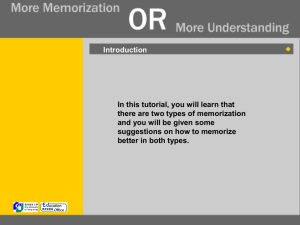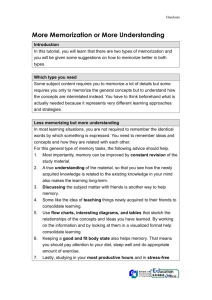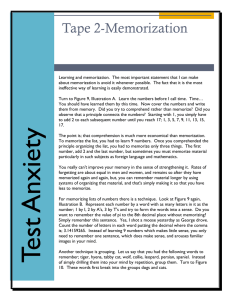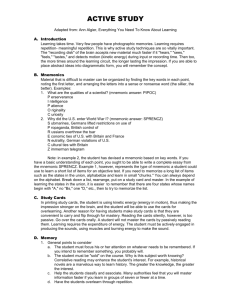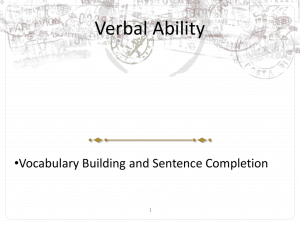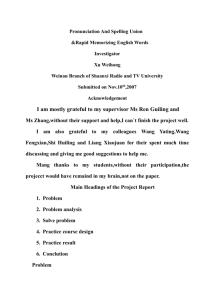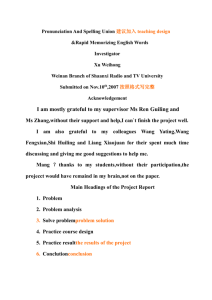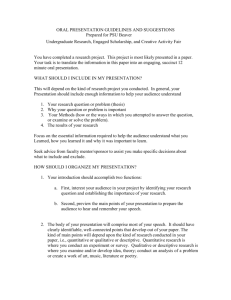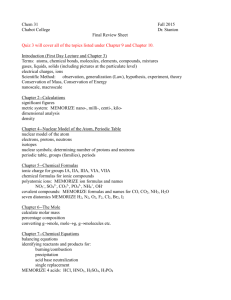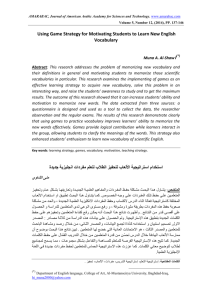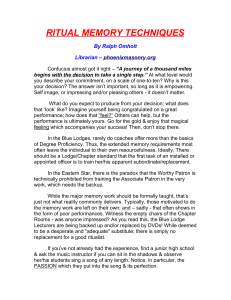Allison-Informative-preparation outline
advertisement
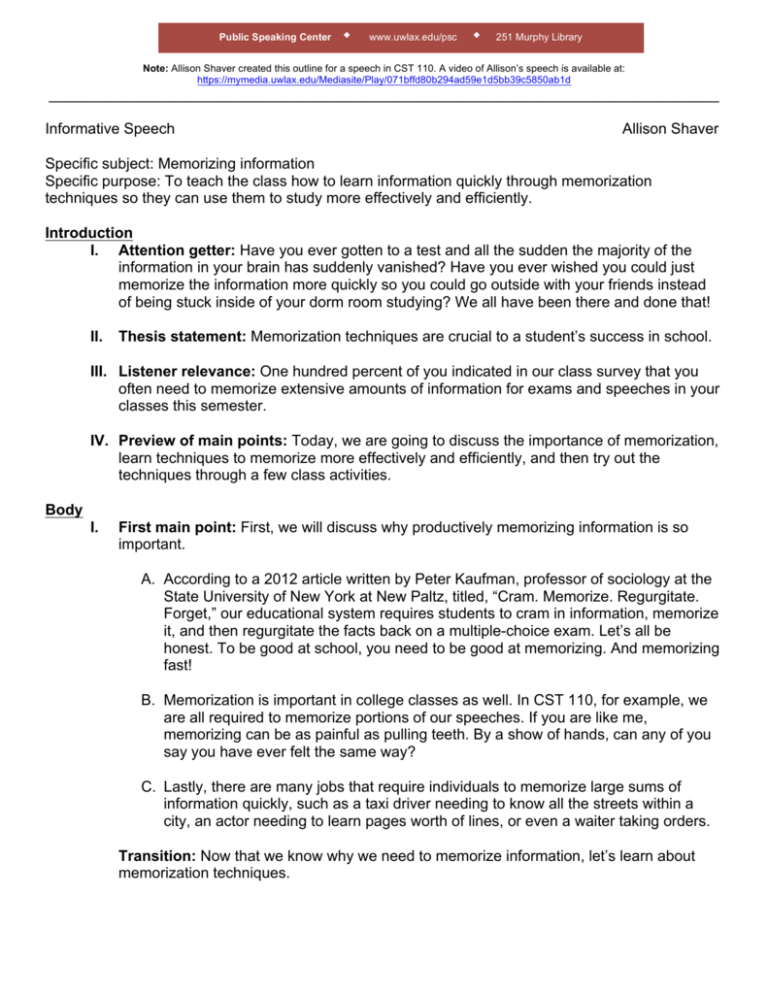
Public Speaking Center w www.uwlax.edu/psc w 251 Murphy Library Note: Allison Shaver created this outline for a speech in CST 110. A video of Allison’s speech is available at: https://mymedia.uwlax.edu/Mediasite/Play/071bffd80b294ad59e1d5bb39c5850ab1d ________________________________________________________________________________ Informative Speech Allison Shaver Specific subject: Memorizing information Specific purpose: To teach the class how to learn information quickly through memorization techniques so they can use them to study more effectively and efficiently. Introduction I. Attention getter: Have you ever gotten to a test and all the sudden the majority of the information in your brain has suddenly vanished? Have you ever wished you could just memorize the information more quickly so you could go outside with your friends instead of being stuck inside of your dorm room studying? We all have been there and done that! II. Thesis statement: Memorization techniques are crucial to a student’s success in school. III. Listener relevance: One hundred percent of you indicated in our class survey that you often need to memorize extensive amounts of information for exams and speeches in your classes this semester. IV. Preview of main points: Today, we are going to discuss the importance of memorization, learn techniques to memorize more effectively and efficiently, and then try out the techniques through a few class activities. Body I. First main point: First, we will discuss why productively memorizing information is so important. A. According to a 2012 article written by Peter Kaufman, professor of sociology at the State University of New York at New Paltz, titled, “Cram. Memorize. Regurgitate. Forget,” our educational system requires students to cram in information, memorize it, and then regurgitate the facts back on a multiple-choice exam. Let’s all be honest. To be good at school, you need to be good at memorizing. And memorizing fast! B. Memorization is important in college classes as well. In CST 110, for example, we are all required to memorize portions of our speeches. If you are like me, memorizing can be as painful as pulling teeth. By a show of hands, can any of you say you have ever felt the same way? C. Lastly, there are many jobs that require individuals to memorize large sums of information quickly, such as a taxi driver needing to know all the streets within a city, an actor needing to learn pages worth of lines, or even a waiter taking orders. Transition: Now that we know why we need to memorize information, let’s learn about memorization techniques. II. Second main point: Second, we will identify three mnemonic devices for memorizing information quickly. A. The first technique is breaking the study material into small chunks like a chunk of cheese off a block. An article published in the journal of Music Performance Research, titled, “Influence of Strategy on Memorization Efficiency,” written by Jennifer Mishra in 2011, from the University of Houston, explains her study on the best way to memorize music. Her findings show that students learn music best when they broke the music up into small pieces practicing only that small section over and over. B. The second technique is using acronyms. Acronyms use the first letter in each word and put them in a meaningful order to help you remember like a downward crossword puzzle. For example, ROYGBIV stands for the colors of the rainbow. Red, orange, yellow, green, blue, indigo, and violet. As Paula Conroy and Peg Collins explain in their 2012 journal article in Insight: Research & Practice In Visual Impairment & Blindness, titled, “Mnemonic Devices for Braille Instruction,” acronyms are an effective way to help students learn Braille more quickly. C. The third technique is using rhyme keys such as “one bun, two shoe, three tree,” in order to help remember items in a list. For example, if you had a grocery list you could remember your list of milk, eggs, and celery by remember “one, I have a soggy bun filled with milk; two, I have a slimy shoe filled with eggs; and three, my celery looks like a tree.” By using your imagination you can quickly remember a list. D. Who can repeat the three mnemonic devices we have just learned? Transition: Now that we have the techniques to memorize information, let’s put the ideas into practice by trying them out. III. Third main point: Third and finally, we will try out the techniques we just learned about in class. A. Now, we will try out the first technique. What was the first technique we learned about again? Chunking. I will put up a series of numbers on the board. We will break these numbers into smaller chunks and practice them over and over until we feel confident. Now that we are confident as a class, please repeat the number that was just on the board. Great job! Chunking does really work! B. It is time to move on to the second mnemonic device, which is an acronym. Let’s pretend that we are trying to memorize the great lakes of Huron, Ontario, Michigan, Erie, and Superior. Can anyone think of an acronym that would work for the lakes? Try rearranging the first letters until you come up with a word. Now, let’s try to remember the lakes again. What are they? C. Lastly, let’s try out the rhyme key technique. Please give me three items we want on our grocery list. Now, we need to connect each thing to a bun, shoe, and tree for one, two, and three. Any suggestions? Can you give me our grocery list now? Conclusion I. Thesis restatement: At last, we all now know how to memorize information in an effective and efficient manner. II. Main point summary: During today’s class, I went over the importance of memorizing information, the techniques used to memorize, and then using those techniques to practice memorizing. III. Clincher: From now on, when you feel like you have forgotten all the information for an upcoming test or want to hurry up your studying time, use the techniques we learned in class today. Make memorizing painless. Not like pulling teeth. References Conroy, P., & Collins, P. (2012). Mnemonic devices for braille instruction. Insight: Research & Practice In Visual Impairment & Blindness, 5(1), 47-52. Mishra, J. (2011). Influence of strategy on memorization efficiency. Music Performance Research, 460-71. Retrieved from http://mpr-online.net/Issues/Volume%204%20[2011]/Mishra.pdf Kaufman, P. (2012, April 26). Cram. Memorize. Regurgitate. Forget. Retrieved from http://www.everydaysociologyblog.com/2012/04/cram-memorize-regurgitate-forget.html
